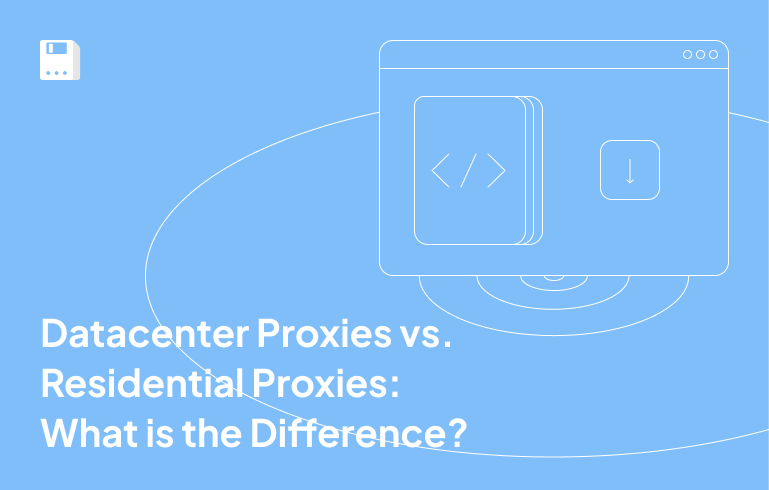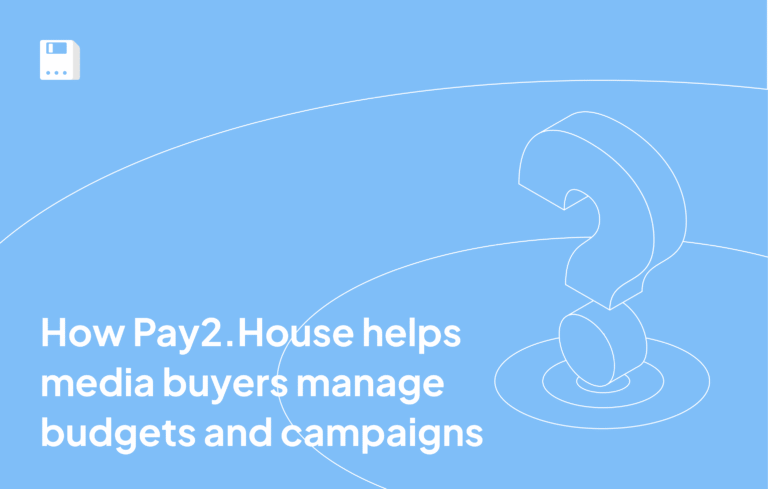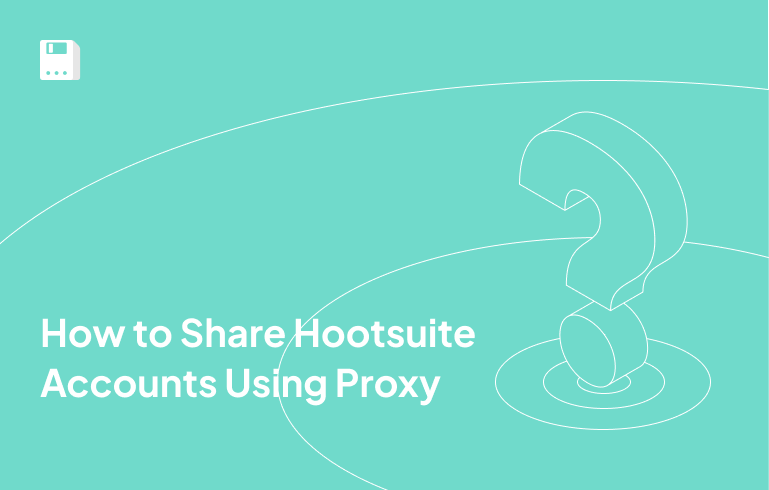Choosing the right proxy type for each project is a fundamental skill when working with proxies. If you’re not using the right type, you’re either wasting money or getting blocked.
Two of the most common proxy types based on the origin of the IP addresses are residential proxies and datacenter proxies. They sound similar, but they work very differently. Understanding the difference between datacenter and residential proxies will save you from headaches down the road.
Datacenter proxies are fast, affordable, and easy to scale, but easier to detect. On the other hand, residential proxies are more private and reliable for geo-targeted actions but can cost more.
In this post, you’ll learn how residential and datacenter proxies compare in terms of speed, cost, privacy, and real-world use cases. By the end, you’ll know exactly how to choose the best fit depending on the project you’re working on.
TL;DR – Datacenter vs Residential Proxies
Here’s a quick recap of the important features to help you decide which proxy type suites you the best:
| Feature | Datacenter Proxies | Residential Proxies |
| Speed | ✅ Very fast | ❌ Slower |
| Anonymity | ❌ Easier to detect | ✅ Higher stealth |
| Cost | ✅ Low cost | ❌ More expensive |
| Detection Risk | ❌ Higher | ✅ Low |
| Geo-Accuracy | ❌ Limited | ✅ Real-world IPs |
| Scalability | ✅ Easy to scale | ❌ Limited by supply |
| Best For | Scraping, testing | Ads, accounts, geo-tasks |
What Are Datacenter Proxies?
Datacenter proxies use IP addresses hosted on virtual machines inside data centers. Unlike residential proxies, those IPs aren’t tied to a physical location or internet service provider (ISP).
They’re created in bulk, which makes them cheap, fast, and scalable. You can spin up thousands in minutes, perfect for big tasks like scraping, monitoring, or testing.
These proxies are often used in tools or bots where you need speed over anonymity.
You can find them across multiple countries or regions. With providers like FloppyData, you can choose datacenter proxies by country to get closer to your target servers.
Key Features of Datacenter Proxies
Let’s start with the pros. Datacenter proxies are loved by developers and marketers for three big reasons:
- Speed – They run on high-performance servers with direct uplinks to the internet. You won’t find a faster option.
- Scalability – Datacenter proxies scale quickly and cheaply.
- Low Cost – Since they’re not tied to a physical ISP or home connection, they’re much more affordable than residential options.
This makes datacenter proxies ideal for high-volume operations where you don’t necessarily need to fly under the radar.
Best Use Cases for Datacenter Proxies
If you’re doing anything at scale online, datacenter proxies likely come into play. A few examples:
- Web scraping – Collecting public data from websites like search engines, eCommerce stores, or booking platforms.
- SEO monitoring – Track keyword rankings across regions without slowing down. Datacenter proxies help you pull large datasets without clogging your pipeline.
- Market research – Run competitor checks or gather pricing data faster using pools of rotating datacenter IPs.
- App and site testing – Need to test from multiple IPs quickly? Datacenter proxies help simulate different users at scale.
Downsides of Datacenter Proxies
Datacenter proxies aren’t perfect. The same traits that make them fast also make them easier to detect:
- Lower Anonymity – Websites often spot datacenter proxies. Since they’re not real user IPs, detection algorithms can flag them.
- Risk of IP Blocks – Sites like Google, Amazon, or Instagram often blacklist datacenter IPs if they detect automation. That’s a problem if you don’t rotate IPs or manage requests smartly.
- Not Ideal for Geo-Sensitive Tasks – Trying to access region-locked content? Datacenter IPs might not cut it. Sites may know the IP is from a server, not a real user in that country.
When Should You Use Datacenter Proxies?
If you’re building something that depends on speed, scale, and cost-efficiency—yes. Datacenter proxies get the job done, especially for technical tasks like scraping and automation.
But if you need high anonymity or plan to interact with platforms that are aggressive about blocking bots, you might run into limits. That’s where residential proxies shine.
What Are Residential Proxies?
Residential proxies use IP addresses assigned by real Internet service providers (ISPs). These IPs belong to actual devices—like home computers, phones, or routers—making them look like real users online.
That’s their biggest strength: authenticity.
Unlike datacenter proxies, which can be spotted as server traffic, residential IPs blend in. They’re tied to real-world locations and behave like normal web traffic, making them much harder to detect or block.
You’re not just renting an IP—you’re stepping into a user’s shoes.
Key Features of Residential Proxies
Here’s what makes residential proxies stand out in the residential vs datacenter proxies debate:
- High Anonymity – Websites trust residential IPs. You’ll face fewer captchas, bans, or blocks—especially on sensitive platforms like social media or eCommerce.
- Geo-Accuracy – These proxies reflect real locations, so if you’re targeting users in Spain or Canada, you can appear to be right there.
- Rotating Options – Many residential proxy networks rotate your IP frequently. That adds another layer of privacy and reduces footprints.
For more details about residential proxies, check out our full guide to residential proxies.
Best Use Cases for Residential Proxies
Residential proxies are a go-to when stealth matters. If your work depends on flying under the radar, this is the right choice.
Here are a few perfect-fit use cases:
- Ad Verification – Ensure ads are shown correctly across regions. Residential proxies make it look like you’re a real viewer in the target country.
- Sneaker Copping & Drops – Popular shoe sites detect and block bots. Residential IPs help you blend in and boost your chances of grabbing limited releases.
- Social Media Management – Running multiple accounts on platforms like Instagram, Facebook, or TikTok? Residential proxies reduce bans and login issues.
- Travel Aggregation – Travel sites change prices by location. Use residential IPs to see what real users see accurately.
Downsides of Residential Proxies
Residential proxies are powerful, but not without trade-offs:
- Slower Speeds – These proxies route traffic through real devices on home networks, which are naturally slower than data center servers.
- Higher Cost – You’re paying for access to legitimate IPs. Expect to spend more than you would for datacenter proxies—sometimes significantly more.
- Limited Availability – You can’t spin up thousands of residential IPs instantly. Supply depends on real users opting in, and not every country is available 24/7.
- Ethical Concerns – Always make sure your provider offers consent-based residential proxies. If the users behind those IPs didn’t agree to be part of the network, you’re stepping into grey territory.
When Should You Use Residential Proxies?
If you’re working on geo-sensitive tasks, account-based platforms, or anything where trust and legitimacy matter, go residential.
Yes, they cost more. But in return, you get better access, fewer roadblocks, and a more natural browsing profile.
When comparing datacenter proxies vs residential, this option wins when detection is the enemy.
What’s the Difference Between Datacenter and Residential Proxies?
You’ve seen how both types work, but how do they stack up side by side? When it comes to datacenter proxies vs residential, the right choice depends on your goals.
Speed vs Stealth
Datacenter proxies are incredibly fast. They run on high-speed servers with direct internet access. For tasks like scraping or SEO checks, speed matters, and these proxies deliver.
Residential proxies, however, route traffic through real devices. That adds latency. You get more privacy but less performance.
So if you need speed, go datacenter. If you need stealth, go residential.
Detection Risk
This is where things flip. Datacenter proxies are easier to spot. Since their IPs come from cloud servers, sites can recognize them as “unnatural” traffic.
Residential IPs come from home users, so they look real. This gives you higher trust with platforms like Google, Instagram, or Amazon.
If you’re worried about bans or captchas, residential wins the detection game.
Price and Availability
Datacenter proxies are cheap and easy to scale. You can get thousands in minutes. This makes them great for big, repetitive tasks.
Residential proxies are harder to get and cost more. That’s because providers need access to real users who’ve opted in—and that comes at a premium.
Use residential proxies when quality matters more than quantity.
How to Choose the Right Proxy for Your Needs
Choosing between residential vs datacenter proxies comes down to what you’re trying to do, and how visible you want to be while doing it.
There’s no one-size-fits-all. Start by asking yourself a few key questions.
Do You Need Speed or Stealth?
If you’re scraping product data from an e-commerce site and want the job done fast, go with datacenter proxies.
They’re fast, affordable, and scale easily. Perfect for tasks where getting blocked isn’t a big deal, or you’ve built error handling into your workflow.
But if you’re dealing with login-protected sites, checking ads, or running automation on social platforms, stealth matters.
That’s where residential proxies shine. They’ll make you look like a normal user and reduce the risk of detection.
What’s Your Budget?
If you’re running a large project with limited spending, datacenter proxies give you the best performance per dollar.
But for high-stakes tasks where a blocked IP means a failed job, residential proxies often pay for themselves by reducing retries and manual fixes.
Think long-term. Cheaper proxies might cost you more if they don’t get the job done.
Are You Targeting Specific Regions?
If geo-location is part of your workflow—whether it’s checking localized content or verifying international ad placements—you’ll need high-quality, geo-accurate IPs.
Residential proxies let you appear in real cities with real ISPs. They’re essential for location-sensitive jobs.
Datacenter proxies can offer region options, but they don’t carry the same local trust signals.
Real-World Strategy: Use Both
Here’s the truth – most professionals don’t stick to just one proxy type.
In my projects, I use datacenter proxies for high-volume scraping and competitor research. They’re fast, affordable, and easy to scale.
But for geo-sensitive tasks like ad verification or managing social accounts, I switch to residential proxies. They’re slower and pricier, but the reliability is worth it.
Using both lets you balance cost and success. It’s a hybrid strategy that helps you stay efficient without getting blocked.
Need more options? Explore more about how different types of proxies stack up against each other in our comprehensive proxy comparison guide.
TL;DR: Quick Recommendations
- Go with datacenter proxies if you need speed, bulk access, and affordability.
- Choose residential proxies for stealth, geo-targeting, and account-based tasks.
- Mix both for complex workflows where cost and detection risk need to be balanced.
Conclusion
So, what’s the real difference between datacenter and residential proxies? It’s all about speed vs. stealth.
Datacenter proxies are fast, scalable, and cost-effective. But they’re easier to detect and best for bulk tasks like scraping or testing.
Residential proxies, on the other hand, offer real-user IPs. They’re harder to block, more private, and ideal for tasks where trust and geo-location accuracy matter.
In the residential vs datacenter proxies debate, there’s no universal winner. It depends on your goals, your platforms, and how much risk you can take.
My advice? Try both. Test small. See what works. Many businesses combine them to get the best of both worlds.
Whatever your needs, FloppyData has you covered. Explore our full range of proxy solutions to find the right fit – by country, by type, or by use case.
Frequently Asked Questions
What Is the Difference Between Datacenter and Residential Proxies?
Datacenter proxies are fast and affordable but easier to detect. Residential proxies use real IPs from ISPs, offering higher anonymity and geo-targeting accuracy.
Which Is Better: Residential or Datacenter Proxy?
It depends on your use case. Datacenter proxies are better for speed, scale, and cost-efficiency. Residential proxies are better for stealth, reliability, and geo-targeted tasks.
When Should I Use Residential Proxies Instead of Datacenter Proxies?
Use residential proxies when you need higher anonymity, are accessing geo-restricted content, managing social media accounts, or performing ad verification. Any task where looking like a real user is essential to avoid detection or bans.
Are Datacenter Proxies Easier to Block?
Yes, datacenter proxies are easier to block because their IPs come from cloud servers, not real users. Many websites can detect this and may flag or ban them, especially during high-volume or automated activity.
Why Are Residential Proxies More Expensive?
Residential proxies are more expensive because they use real IPs from actual devices connected via ISPs. These IPs are harder to obtain, rotate, and maintain, especially when sourced ethically with user consent, making the service costlier to provide.
Can I Use Both Datacenter And Residential Proxies Together?
Yes, many professionals use both. Datacenter proxies handle bulk tasks cost-effectively, while residential proxies are used for stealth or geo-targeted actions. Combining them lets you balance speed, cost, and reliability.
Are Residential Proxies Legal And Safe to Use?
Yes, residential proxies are legal to use as long as they’re obtained through legitimate providers like FloppyData who ensure consent from the individuals whose IPs are part of the network.
What’s the main difference between datacenter and residential proxies?
Datacenter proxies are fast, scalable, and budget-friendly but easier to detect. In contrast, residential proxies use real ISP-assigned IPs, offering greater anonymity, geo-accuracy, and resistance to blocks - though they’re costlier and slower.
When should I choose each proxy type?
Use datacenter proxies for high-volume, low-cost tasks like large-scale scraping or testing. Opt for residential proxies when stealth, geo-targeting accuracy, or account safety matters - such as ad verification or social media management.
Share this article:
Table of Contents
Proxies at $1
Get unlimited possibilities










